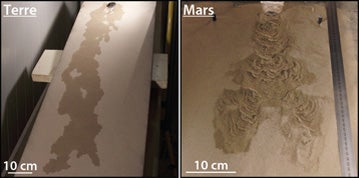It is well known that water boils at 100°C. But this is only true at sea level, since boiling point depends on atmospheric pressure: the higher the altitude, the thinner the atmosphere, and the lower the boiling point. For instance, at the top of Mount Everest, water boils at 60°C. But on Mars, where the atmosphere is much thinner than on Earth, it can boil at temperatures as low as 0°C. During the martian summer, when the subsurface water ice begins to melt and emerge at the surface, where the mean temperature reaches 20°C, it immediately starts to boil. This is also the case for the flows of saline water discovered last year. So could an evaporating liquid alter the martian landscape?
To find out, a team of researchers from the Open University in the United Kingdom used a former diving decompression chamber to reproduce the low pressure of the martian atmosphere. At the same time, another team from the GEOPS laboratory (CNRS/Université Paris-Sud) carried out the same experiment, but this time in a cold chamber at Earth’s atmospheric pressure. In both chambers, a block of pure water ice, followed by one of saline water ice, was melted at a temperature of 20°C (as on Mars in summer) on a sand-covered slope.
The experiments showed that in the flows produced under terrestrial conditions, the water gradually seeped into the sand, leaving no trace on the surface after drying. However, what was observed in the martian chamber was very different. The water produced by the melting ice started to boil as soon as it reached the surface, and the gas released caused the ejection of sand grains. These gradually formed small ridges at the front of the flow, which, as they grew larger, became unstable and actually produced avalanches of dry sand. The process was even more violent at lower pressures. Contrary to what is observed on Earth, the surface, once dry, therefore exhibited a series of ridges.
This process is not as efficient in the case of saline water since it is more stable than pure water under martian conditions. However, since saline water is more viscous, it can carry along sand grains and form small channels, a process that can sometimes become explosive under low pressure.
These findings, analyzed along with other laboratories worldwide, including the Institut d’Astrophysique Spatiale (CNRS/Université Paris Sud), provide new insight into the effect of the flow of water — whether saline or not — on the surface of Mars. Far from making its action insignificant, the water’s instability considerably increases its impact on surface morphology. This broadens the potential range of processes that could explain the activity on the martian surface, such as that observed in spring on the planet’s slopes during the melt of winter frost made up of CO2 and water ice, as well as the dark flows — recurring slope lineae — seen in summer.
The possible presence of liquid water on the surface of Mars is a key question in the search for environments potentially favorable to life. Until now, detecting liquid water depended on identifying morphologies similar to those produced on Earth by the flow of liquid water, such as channels, gullies, or simply the seasonal appearance of dark traces caused by dampening of the surface. However, the flows produced in the laboratory show that morphologies produced under either martian or terrestrial conditions are different. Direct comparison between landforms produced on Earth and on Mars does not therefore appear to be appropriate for detecting the appearance of a liquid on Mars, thus altering our interpretation of the martian surface.










